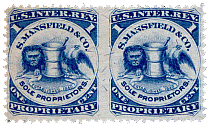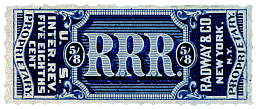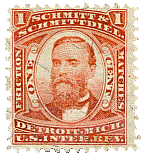
Private Die Proprietary Stamps
(The "Match and Medicine" Stamps)
|
The Tax Laws of 1862 were passed to help the North pay the costs of the United States Civil War. Among the items taxed in this and subsequent laws were matches, patent medicines, perfumes, playing cards and, for a short time, canned fruit.
Section 99 of the revenue law stated, "That any proprietor or proprietors of proprietary articles, or articles subject to stamp duty under schedule C of this act, shall have the privilege of furnishing, without expense to the United States, in suitable form, to be approved by the Comissioner of Internal Revenue, his or their own dies or designs for stamps to be ued thereon, to be retained in the possession of the Comissioner of Internal Revenue, for his or their separate use, which shall not be duplicated to any other person. That in all cases where such stamp is used, instead of his or their writing, his or their initials and the date thereon, the said stamp shall be so affixed on the box, bottle, or package, that in opening the same, or using the contents thereof, the said stamp shall be effectually destroyed;..."
|
A discount was provided for companies using private die stamps. From Section 102: "That any proprietor or proprietors of articles named in schedule C, who shall furnish his or their own die or design for stamps, to be used especially for his or their own proprietary articles, shall be allowed the following discount, namely: on amounts purchased at one time of not less than fifty nor more than five hundred dollars, five per centum; on amounts over five hundred dollars, ten per centum."
A number of companies availed themselves of the "free" advertising and discount available through use of private die stamps. With a few exceptions, these stamps were printed by Butler & Carpenter (later Joseph R. Carpenter) of Philadelphia until August 31, 1875. Between September of 1875 and October 1880 the stamps were printed by the National and American Bank Note Companies, and in 1880 the Bureau of Engraving and Printing assumed the job, until July, 1883 when the proprietary taxes ended.
|

Four major varieties of paper were used in printing these stamps. Until September of 1871 they were printed on white, unwatermarked paper, referred to as "old paper." Some of this paper had widely scattered silk threads, and is considered a minor variety, "experimental silk." The full "silk paper" contains numerous threads, and was used between 1871 and late 1877 or early 1878.
"Pink paper" was used for a short time in 1877-8, and "watermarked paper," with the USIR watermark, was used from late 1877 or early 1878 until the end of the tax period in 1883.
A look at the paper types.

|
Private die proprietary stamps were used again from July 1, 1898 until July 1, 1902 to help fund the Spanish American War. Patent medicines, perfumery and cosmetics, chewing gum and sparkling wines were taxed, but only a handful of the medicine and perfumery companies chose to use private die stamps. There are 29 face- and denomination-different issues.
|
Two types of perforations were used in connection with these stamps: rouletting and hyphen-hole perforations. Not all were issued with both types. Other, related issues are the "Saint Louis" Provisional Stamps and the Dr. Kilmer & Co. Provisionals.
|

There are several ways to collect private die stamps. One is to try for a copy of every paper type for every stamp. Another is to collect one of each of the design- and denomination-different varieties, ignoring type of paper. Other, more specialized collections can be made as well.
This website illustrates most of the design- and denomination-different private die stamps. Some are extremely rare, and occasionally no examples are currently available to the author.
|
The Scott catalog numbers are assigned alphabetically by user, with different prefixes for the different types: RO for match stamps, RP for the canned fruit stamp, RS for the patent medicine stamps, RT for the perfume stamps and RU for the playing card stamps. The links to the right lead to listings with links to illustrations of most of the stamps.
The thumbnail site is based on pages developed by the late Sherwood Springer. Springer grouped many similar stamps in order to make balanced page layouts, so the stamps are often not in alphabetic order by company. Each thumbnail will lead to a life-size page. On these pages it is possible to see the catalog number of any stamp by holding the mouse pointer over the image, and each image is a link to a larger illustration of, and information about, the stamp.
|
|
Listings by Name
RO (match)
RP (canned fruit)
RS (medicine)
RT (perfume)
RU (playing card)

|
Print References: Toppan, George L., Deats, Hiram E., Holland, Alexander, The Boston Revenue Book, Newcom & Gauss, 1899 (reprint by Quarterman Publications) Mahler, Michael, United States Civil War Revenue Stamp Taxes,Castenholz and Sons, 1988 West, Christopher (Elliott Perry), United States Match and Medicine Stamps, Castenholz and Sons, 1980 West, Christopher (Elliott Perry), Private Die Match Stamps, Castenholz and Sons, 1980 Holcombe, Henry, Patent Medicine Tax Stamps,Quarterman Publications, Inc., 1979 Griffenhagen, George, Private Die Proprietary Medicine Stamps,American Topical Association, 1969 Aldrich, Michael, A Census of United States Match and Medicine Stamps, Aldrich Publishing, 1997
Return
|




